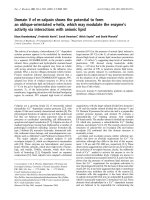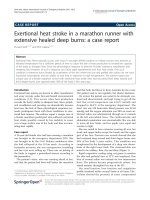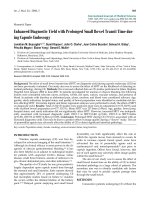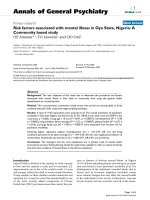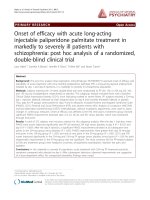Báo cáo y học: "Severe heat stroke with multiple organ dysfunction" pot
Bạn đang xem bản rút gọn của tài liệu. Xem và tải ngay bản đầy đủ của tài liệu tại đây (30.28 KB, 2 trang )
Page 1 of 2
(page number not for citation purposes)
Available online />In a case report recently published in Critical Care,
Broessner and coworkers [1] claim to have successfully
treated a patient with heat stroke by using a specific cooling
device. We should like to raise some important issues.
First, why were nonsteroidal anti-inflammatory drugs
(NSAIDs) used acutely as a primary cooling method? No
evidence supports the use of NSAIDs to reduce temperature
during the acute phase of heat stroke. Moreover, they can be
deleterious to the patient [2]. A rationale for the use of
NSAIDs should be provided.
Second, why were conventional cooling techniques
terminated after 8 hours when the graph (Figure 1 in the
report by Broessner and coworkers [1]) indicates that body
temperature was effectively lowered to below 39°C (the initial
goal in treatment of heat stroke)? We question the cooling
technique, because aggressive conventional cooling in the
intensive care unit should achieve 39°C within 1 hour [3].
Third, were NSAIDs continued during use of the CoolGard
®
device? If so, then it would be difficult to assess the physiologic
significance and effectiveness of the cooling device.
Finally, is it not likely that an ongoing infection (in this case
sinusitis) could have played some causative role with respect
to the severity and complications associated with the heat
illness? Although the initial computed tomographic diagnosis
and physical examination did not reveal any pathology, it was
later reported that computed tomography was consistent with
sinusitis maxillaris and aspiration pneumonia. These infections
might have had an impact on the responses and later
complications, but this possibility was not discussed as a
potential contributing factor.
Letter
Severe heat stroke with multiple organ dysfunction
Yuval Heled and Patricia A Deuster
Human Performance Laboratory, Department of Military and Emergency Medicine, Uniformed Services University of the Health Sciences, Bethesda,
Maryland, USA
Corresponding author: Yuval Heled,
Published: 21 March 2006 Critical Care 2006, 10:406 (doi:10.1186/cc4885)
This article is online at />© 2006 BioMed Central Ltd
See related research by Broessner et al. in issue 9.5 [ />Authors’ response
Gregor Broessner, Ronny Beer, Gerhard Franz, Peter Lackner, Klaus Engelhardt, Christian Brenneis, Bettina Pfausler
and Erich Schmutzhard
We read with interest the letter by Drs Heled and Deuster
regarding our case report of a novel intravascular treatment
approach in heat stroke.
Immediate cooling and support of organ system functioning
are the two main therapeutic objectives in patients with heat
stroke [4]. As a consequence of that, we intended to lower
the patient’s highly elevated body core temperature by using
conventional temperature control measures during the acute
phase of the disease. Antipyretics are widely used to combat
hyperthermia, although the use of pharmacologic agents in
heat stroke is controversially discussed in the literature [4,5].
In our opinion, the role of antipyretic agents in heat stroke is
still unclear, despite the fact that pyrogenic cytokines have
been implicated in its development and may be influenced by
such drugs.
Despite the aggressive use of conventional temperature
control methods, including antipyretics and surface cooling
techniques, for the first 20 hours of treatment (the red line in
Figure 1 of our report [1]), we could not control the patient’s
body core temperature. Physical means to lower temperature,
including surface cooling, have been shown to be ineffective
in many studies because these methods can have limited
efficacy as a result of skin vasoconstriction and shivering [5,6].
While using the novel intravascular treatment device, we did
not add or continue any conventional treatment except for
Page 2 of 2
(page number not for citation purposes)
Critical Care Vol 10 No 2 Heled and Deuster
opioids for analgesia, because control of body core
temperature was achieved by endovascular treatment alone.
This system has been shown to be more effective in
preventing fever than conventional methods, such as anti-
pyretic medications and surface cooling techniques [7].
We concede that the aspiration pneumonia and the sinusitis
maxillaris might have had an additional effect on the severity
of heat stroke in this particular case, although adequate
antimicrobial treatment was started immediately and should
have controlled these infections.
In our reported case conventional temperature control
methods were ineffective in combating hyperthermia, but
endovascular treatment was effective, feasible and
instrumental in achieving a favourable outcome. Thus, further
prospective randomized and controlled studies are warranted
to evaluate the various treatment possibilities in heat stroke.
Competing interests
The authors declare that they have no competing interests.
References
1. Broessner G, Beer R, Franz G, Lackner P, Engelhard K, Brenneis
C, Pfausler B, Schmutzhard E: Case report: severe heat stroke
with multiple organ dysfunction – a novel intravascular treat-
ment approach. Crit Care 2005, 9:R498-R501.
2. Walker JS, Hogan DE: Heat emergencies. In Emergency Medi-
cine: A Comprehensive Study Guide, Section 15. Edited by Tinti-
nalli JE, Kelen GD, Stapczynski S. American College of
Emergency Physicians; 2004:1183-1189.
3. Smith JE: Cooling methods used in the treatment of exertional
heat illness. Br J Sports Med 2005, 39:503-507.
4. Bouchama A, Knochel JP: Heat stroke. N Engl J Med 2002, 346:
1978-1988.
5. Diringer MN: Treatment of fever in the neurologic intensive
care unit with a catheter-based heat exchange system. Crit
Care Med 2004, 32:559-564.
6. Schmutzhard E, Engelhardt K, Beer R, Brossner G, Pfausler B,
Spiss H, Unterberger I, Kampfl A: Safety and efficacy of a novel
intravascular cooling device to control body temperature in
neurologic intensive care patients: a prospective pilot study.
Crit Care Med 2002, 30:2481-2488.
7. Marion DW: Controlled normothermia in neurologic intensive
care. Crit Care Med 2004, 32:S43-S45.



